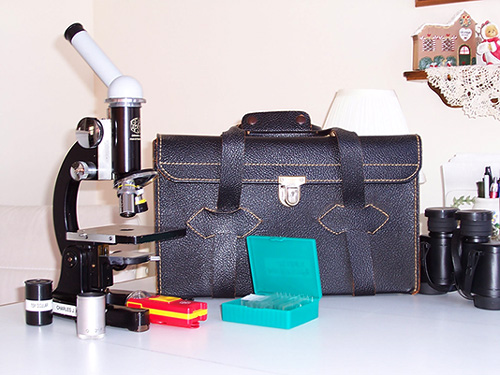
|
A Full-size Field Microscope by Chuck Huck, USA |
As microscopists, we sometimes travel to distant places where ponds, lakes, oceans, streams or rivers are within our reach. On such occasions we often wish we had a microscope handy to view samples of the local microlife existing in these bodies of water.
Wherever I go, I usually carry a 10X pocket magnifier and a pair of binoculars (always in the car, or in my suitcase). I realize there are some excellent portable mini-microscopes, such as the Swift, Nikon and others. But these are sometimes difficult to obtain and are very expensive.
A few years ago, I purchased two Graf Apsco microscopes off eBay for a very reasonable price (see my previous article). I decided to convert one of the microscopes (which did not have a mechanical stage, condenser or objectives) to a field microscope.
First, I equipped the microscope with spare 4X and a 10X objectives and a spare 15X widefield eyepiece. Over the condenser holder I taped a piece of ground glass. Since there is no mirror, I use a small inclined flashlight just beneath the ground glass. The flashlight is moved around so that the illumination in the field as viewed through the eyepiece is pefectly even. Additional pieces of ground glass may be used to diminish illumination if needed.
The flashlight is very useful because there is no need to search for a mains or electrical power outlet, and the light is always the same intensity. Extra batteries for the flashlight are a must. Although somewhat heavy, the microscope stored in an old camera case with collecting jars, pipettes, slides, a magnifier, flashlight, etc., can easily be stored in the boot or trunk of an automobile or other conveyance. It is certainly not recommended for long hikes through the woods.
On a trip to northern Wisconsin some time ago, I took this field unit and used it to examine pond samples in a motel room. Since there is no condenser, I use magnifications of only 60X and 150X maximum. The quality of the image is quite good. Higher magnifications with this setup would result in inferior resolution. Although I have not done so as yet, one could use a digital camera to shoot pictures of pond samples in the field, be it in a hotel room or on a picnic table near a pond. An interesting project would be to use it outdoors to view or photograph snow flakes.
The photo shows the microscope with a "homemade" 45-degree angle tube with prism permanently cemented to the main body with Amazing Goop. The tube is unscrewed from the prism housing so the scope can be stored in the camera case with the arm facing up. The black film container houses the 15X eyepiece. Also shown are a 5X magnifier and box of microscope slides with cover slips plus the angled flashlight.
This microscope setup is useful only for field use, either outdoors or indoors, and is not intended to take the place of a full-service microscope used at home for critical study.
Comments to the author, Chuck Huck, are welcomed.

Please report any Web problems or offer general comments to the Micscape Editor.
Micscape is the on-line monthly magazine of the Microscopy UK web site at Microscopy-UK.